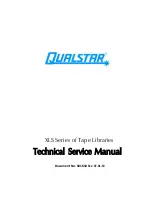
4
3 – Drive Mode Descriptions
RAID 5: Striping, Parity Distributed Among Drives
RAID 5 configuration increases reliability while using fewer
drives than RAID 10 mirroring by using parity redundancy:
parity is distributed across multiple drives. Any one of
the four drives can fail, and the volume will continue to
function. See
Figure 8
. When the failed drive is replaced, the
parity data on the three other drives is used to rebuild the
RAID volume with data spread across all four drives.
In the R400 RAID USB 3.0, RAID 5 configuration offers 75%
of the four drives’ total capacity. For example, if your system
has four 4TB drives, the total unformatted capacity is 16TB.
After configuring the drives in RAID 5 mode, approximately
12TB is available for storage, with the other 4TB set aside for
parity.
JBOD: Just a Bunch of Disks
JBOD mode enables all four drives to be available
individually at the same time for normal storage operations.
See
Figure 9
.
JBOD provides no data protection
.
JBOD offers the full capacity of each of the drives.
Disk 1
Data 1
Data 5
Data 9
Parity
10–12
Disk 2
Data 2
Data 6
Parity 7–9
Data 10
Disk 3
Data 3
Parity 4–6
Data 7
Data 11
Disk 4
Parity 1–3
Data 4
Data 8
Data 12
RAID 5:
Striping, Parity Distributed Among Drives
Stripe 1
Stripe 2
Stripe 3
Stripe 4
Figure 8
Disk 1
Data 1
Data 2
Data 3
Data 4
Disk 2
Data 5
Data 6
Data 7
Data 8
Disk 3
Data 9
Data 10
Data 11
Data 12
Disk 4
Data 13
Data 14
Data 15
Data 16
JBOD (Just a Bunch of Disks)
Figure 9
Содержание Fusion R400
Страница 2: ......
Страница 4: ...This page left intentionally blank ...






























